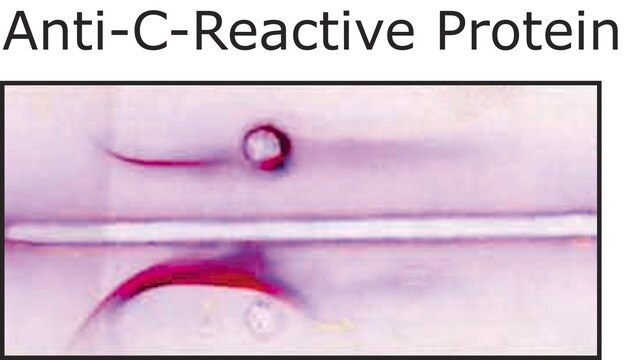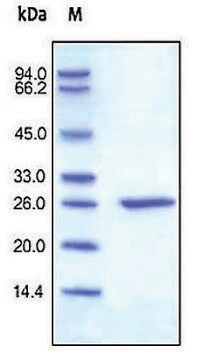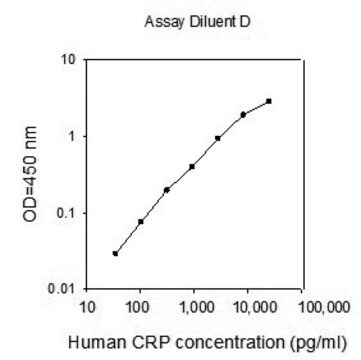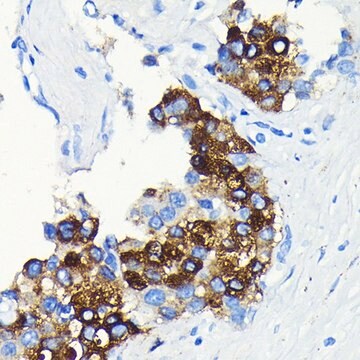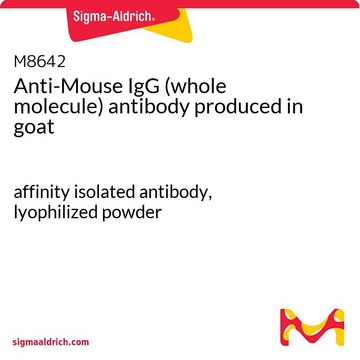C1688
Monoclonal Anti-C-Reactive Protein antibody produced in mouse
clone CRP-8, ascites fluid
Sinónimos:
Anti-CRP
Iniciar sesiónpara Ver la Fijación de precios por contrato y de la organización
About This Item
Productos recomendados
origen biológico
mouse
Nivel de calidad
conjugado
unconjugated
forma del anticuerpo
ascites fluid
tipo de anticuerpo
primary antibodies
clon
CRP-8, monoclonal
mol peso
antigen 24 kDa
contiene
15 mM sodium azide
reactividad de especies
human
técnicas
dot blot: suitable
indirect ELISA: 1:40,000
western blot: 1:200
isotipo
IgG1
Nº de acceso UniProt
Condiciones de envío
dry ice
temp. de almacenamiento
−20°C
modificación del objetivo postraduccional
unmodified
Información sobre el gen
human ... CRP(1401)
Categorías relacionadas
Descripción general
C-reactive protein (CRP) is a member of the pentraxin family of proteins and synthesized by the liver. It is also known as PTX1. The CRP gene is mapped to human chromosome 1q23.2.
Especificidad
The antibody recognizes an epitope located on the 24 kDa subunit of denatured and reduced CRP. It does not cross-react with human serum amyloid P component (SAP), human haptoglobin, human α1-acid glycoprotein, human IgG, and CRP from Limulus.
Inmunógeno
human C-reactive protein.
Aplicación
- It has been used in immunoblotting assay, to identify monomeric CRP.
- In time-resolved fluorometric assay.
Monoclonal Anti-C-Reactive Protein antibody produced in mouse is suitable for the following:
- dot blot analysis
- indirect ELISA at a working dilution of 1:40,000
- western blotting at a working dilution of 1:200
Acciones bioquímicas o fisiológicas
C-reactive protein (CRP) shows essential scavenging and metabolic activity and is also associated with defence mechanism. It activates the complement pathway by binding to calcium-dependent exogenous and autologous molecules containing phosphocholine (PC). It may have pathogenic effects and is a practical prognostic marker in patients with hepatocellular carcinoma (HCC). The CRP diagnostic value is higher for acute pyelonephritis than lower urinary tract infection. Thus, it helps in differentiating between upper and lower urinary tract infection. It is considered best for predicting the risk of cardiovascular disease..
Cláusula de descargo de responsabilidad
Unless otherwise stated in our catalog or other company documentation accompanying the product(s), our products are intended for research use only and are not to be used for any other purpose, which includes but is not limited to, unauthorized commercial uses, in vitro diagnostic uses, ex vivo or in vivo therapeutic uses or any type of consumption or application to humans or animals.
¿No encuentra el producto adecuado?
Pruebe nuestro Herramienta de selección de productos.
Código de clase de almacenamiento
12 - Non Combustible Liquids
Clase de riesgo para el agua (WGK)
WGK 1
Punto de inflamabilidad (°F)
Not applicable
Punto de inflamabilidad (°C)
Not applicable
Elija entre una de las versiones más recientes:
¿Ya tiene este producto?
Encuentre la documentación para los productos que ha comprado recientemente en la Biblioteca de documentos.
Los clientes también vieron
C-reactive protein specifically enhances platelet-activating factor-induced inflammatory activity in vivo.
Sato A, et al.
European Journal of Pharmacology, 745, 46-51 (2014)
Aleksandra N Klisic et al.
Laboratory medicine, 45(1), 12-16 (2014-04-12)
Although C-reactive protein (CRP) is among the best cardiovascular disease risk predictors, data regarding the association of CRP and menopause are controversial. In this study, we measured CRP by a high-sensitivity method (hsCRP), cholesterol, lipoproteins, and triglycerides in normal and
Birgit Fendl et al.
Scientific reports, 11(1), 6996-6996 (2021-03-28)
There is increasing evidence that C-reactive protein (CRP) can mediate inflammatory reactions following the transformation of functionally inert pentameric CRP (pCRP) into its structural isoform pCRP* and into monomeric CRP (mCRP). This conversion can occur on the membranes of apoptotic
Rui-Ying Xu et al.
BMC urology, 14, 45-45 (2014-06-03)
Urinary infections are a common type of pediatric disease, and their treatment and prognosis are closely correlated with infection location. Common clinical manifestations and laboratory tests are insufficient to differentiate between acute pyelonephritis and lower urinary tract infection. This study
Akiyoshi Kinoshita et al.
Oncology, 86(5-6), 308-317 (2014-06-14)
C-reactive protein (CRP) is a practical prognostic marker in patients with hepatocellular carcinoma (HCC). We investigated the prognostic value of adding the CRP level to other validated staging systems (Cancer Liver Italian Program, Japan Integrated Staging, Barcelona Clinic Liver Cancer
Nuestro equipo de científicos tiene experiencia en todas las áreas de investigación: Ciencias de la vida, Ciencia de los materiales, Síntesis química, Cromatografía, Analítica y muchas otras.
Póngase en contacto con el Servicio técnico

